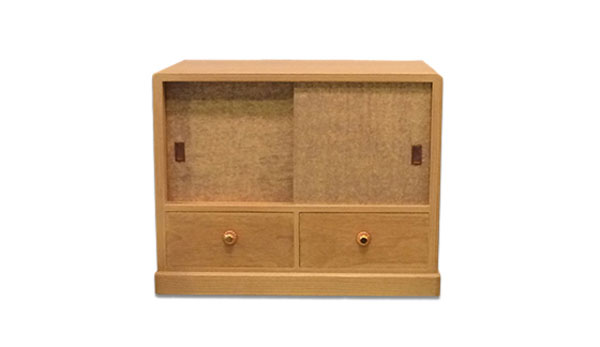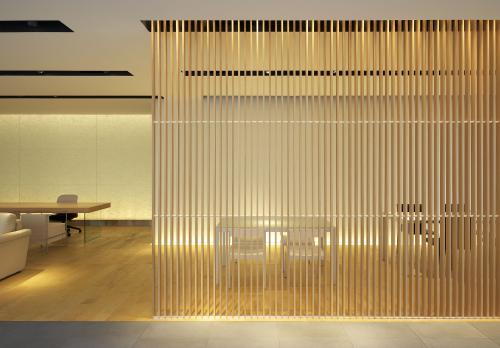
- Wood, bamboo crafts
- Kyoto
Kyo wood joinery Kyo sashimono
Designs developed through history and culture
Techniques bringing out the beauty of wood
Description
What is Kyo wood joinery ?
Kyo Sashimono is a kind of wood joinery produced in the prefecture of Kyoto. Sashimono is a collective name for furniture and furnishings assembled with wood joints that originates from the process of measuring with a monosashi or woodwork ruler. There are many paulownia wood products of this craft, such as furniture, tea ceremony tools, and lathe-turned items. It is said that more than five hundred types of products can be created using several techniques. Kyo Sashimono has elegant designs unique to Kyoto as it is said to have originated in the Heian period (794-1185), when the court culture pursued high quality. In addition, as this craft comes from both the simple tea ceremony culture, and the merchant culture of the Edo period, it has an interesting variety of designs reflecting these influences. Kyo Sashimono also has a wealth of techniques that have been passed down with wood joinery carpenters developing techniques suited to the needs of each era, simply adding them to the growing repertoire of traditional and imported techniques. Today’s crafts are a testament to the skills and experience of artisans, as well as hundreds of years of tradition.
History
Kyo Sashimono is said to have originated in the Heian period, but with the abundance of forests in Japan, wood crafts unique to Japan were already in existence before the Heian period. Japan was impacted by stone and metal crafts that came from China and Korea. They started copying those pieces and at the same time created their own crafts using wood. The main items produced during the Heian period were rulers used for court ceremonies. In the Muromachi period (1336-1573), there were specialized craftsmen joiners as the increasingly wealthy samurai society led to a demand for furniture such as chests of drawers, shelves, and desks. The demand for Kyo Sashimono increased again in the Azuchi-Momoyama period (1574-1600) due to the spread of tea ceremony culture. This craft began to be used as part of shoin-zukuri residential architecture, tatami rooms, tea ceremony tools, and furniture. A wide variety of Kyo Sashimono began to be produced in the Edo period, for use by samurai, merchants, and kabuki actors which gave rise to the further development of new techniques. Now, items suited for modern times, such as champagne coolers and Japanese style lighting are being produced. These products convey the warmth of wood in their contemporary designs, which is why they are still popular today.
Production Process
- 1. Rough wood preparation
Paulownia, cherry, Japanese cedar, pine, Japanese zelkova, or Japanese cypress wood that has been left to dry over a long period of time is used for Kyo Sashimono. The following is the production process of a paulownia chest of drawers, which is one of the major Kyo Sashimono products. Paulownia is suited for storage furniture as it is naturally insect repellant, and is resistant against heat and water. Also, the quality of the wood is uniform and does not stain easily. Paulownia chest of drawers are carefully made with high quality materials and have a reputation as a high end product. The process starts with the production of the base, which is made over a number of years. In order to prevent any further growth the bark is peeled from the timber logs, piled sideways, and exposed to the weather for over a year. Then the raw timber is sawn to size and dried for over a year. After the wood has been cut into the required size boards and square timber, it is dried and marked according to the dimensions of the chest, cut, and prepared.
- 2. Straightening
Warped or curved wooden boards are straightened by dousing the inner curve with water while the outer curve is held over a fire. A stone is laid on the board for twenty four hours to straighten out the curve. Knowing the correct balance between time on the fire to the amount of water requires years of experience.
- 3. Rough cutting
The straightened planks and boards are cut to size.
- 4. Sizing
The wood is marked based on the size and shape, using carpenter’s squares and wooden patterns. A shirakaki knife, instead of pencils or ink, is used to mark the wood with thin and precise lines.
- 5. Processing wooden joints
A technique called kumitsugi is used to join pieces of wood together. There are various types of joining like the two-piece, three-piece, and even five-piece kumitsugi. They improve both the appearance and strength of the furniture.
- 6. Production of wooden pegs
Wooden pegs are made of wood from a deutzia tree. The wood is cut to approximately twenty centimeters length, and then cut into boards four to six millimeters thick using a nata hatchet. The boards are cut further along the grain into sticks resembling chopsticks about four to six millimeters wide. They are then shaved roundly with a knife and cut into the appropriate lengths for wooden pegs. Each stick generally yields around four to eight wooden pegs, which are then roasted with rice bran to remove moisture.
- 7. Assembly
Glue is prepared by thoroughly kneading rice grains with a spatula. The joints are assembled, glued, and holes are drilled through with a gimlet. A small amount of glue is applied to the tip of the wooden peg, which is then securely driven into the hole with a hammer. The assembled drawers are adjusted and shaved with a plane to a perfect fit.
- 8.Finishing cut
This process involves shaving the joints and external parts with a Japanese hand plane. This ensures a smooth and even surface, while curved edges are rounded.
- 9. Finishing
The surface is polished using sandpaper and natural polishing agents such as rough horsetail and muku (oriental elm) tree leaves. Finishing processes bring out the unique features of the wood. For paulownia wood, hana-ibotaro wax, which is a tree wax made from secretion of scale insects, is placed inside a cotton bag and used to polish the surface of the wood. This method is called the ibotaro wax wiping finish.
- 10. Decorations
The finished furniture may sometimes be decorated using maki-e, where gold and silver powder is sprinkled over lacquer drawings, or inlaid decorations. Metal fittings such as handles ordered and manufactured separately are attached, and the Kyo Sashimono dresser is complete.
Representative Manufacturers
Miyazaki furniture

Kyo woodworks & joinery was first created in the aristocracy during the Heian period (794-1185) and developed during the Muromachi period (1336-1573) with the expansion of the tea ceremony culture.
It often uses pawlonia or Japanese cypress wood, as well as black lacquer and other types of decorative techniques for lacquerware such as raden or metal works for simple and elegant ornaments.
-
Founded1856
-
ClosedWednesdays / Around the New Year / Mid-August
-
DirectorMariko MIYAZAKI
-
Business Hours10am to 7pm
-
Address
-
Website
-
Tel.+81-75-231-6337
Facility Information
Kyoto Museum of Crafts and Design

-
Address
-
Tel.+81-75-762-2670
-
ClosedDecember 29 to January 3
-
Business Hours9am to 5pm
-
Website
Related Artists
- You will be redirected to the artist's page on the Gallery Japan website
Other Wood, bamboo crafts
- Hakone wood mosaic
- Iwayado traditional chest
- Kaba cherrybark woodcrafts
- Odate bentwood
- Inami wood carvings
- Matsumoto furniture
- Beppu bamboo crafts
- Edo wood joinery
- Ichii woodcarvings
- Suruga bamboo crafts
- Edo bamboo fishing rods
- Kishu bamboo fishing rods
- Kamo traditional chest
- Kyo wood joinery
- Miyakonojo archery bows
- Osaka carved wooden panel
- Miyajima woodwork
- Nibutani carved wooden tray
- Okuaizu Basketry
- Echizen traditional chest
- Kasukabe traditional paulownia chest
- Katsuyama bamboo crafts
- Osaka karaki wood joinery
- Takayama tea whisks
- Toyooka wicker crafts
- Akita cedar tubs and barrels
- Nagiso woodturning
- Kishu traditional chest
- Nagoya traditional paulownia chest
- Osaka bamboo screens
- Osaka-senshu traditional paulownia chest
- Sendai traditional chest































































































































































































































































































